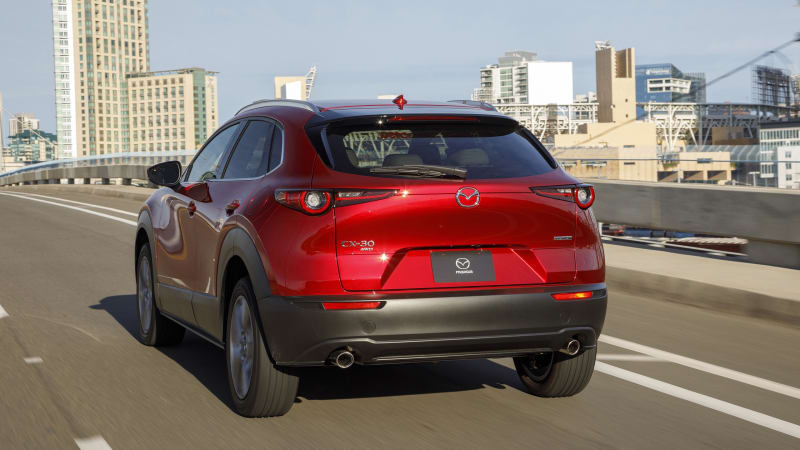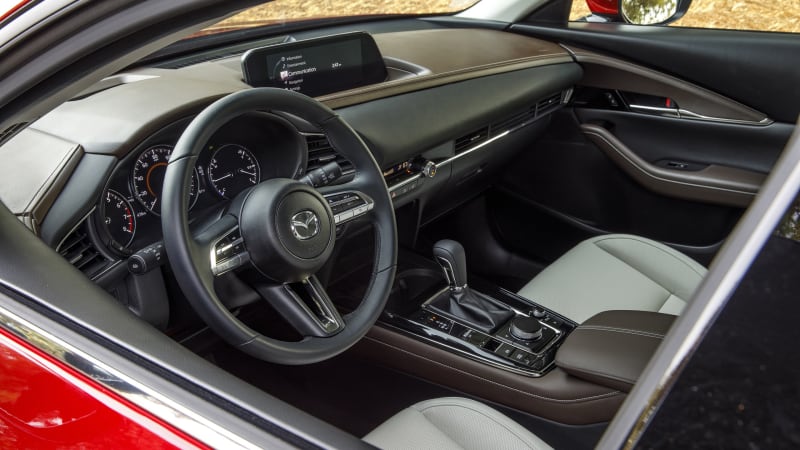JULIAN, Calif. — An Aveo wanders in the lane ahead, its gas flap open and waving in the 30-mph slipstream as it creeps along some of the best roads in all of Southern California as swiftly as a retreating glacier. The 2020 Mazda CX-30’s speedometer needle quivers and then falls. The longing for a passing zone becomes unbearable. Even with a merely adequate 186 horsepower and a standard automatic, I can’t wait to smoke this Aveo as I arc into another corner, tap brakes to transfer weight, and scoot into the next. And then a sort of calm washes over, provoking the slightest smile.
The smile is a realization that, short of a few performance models from the German brands, most compact crossovers don’t beg for this sort of action. The CX-30 is not most crossovers – it’s built on the bones of the dynamically overachieving Mazda3, making it legitimately rewarding to drive. Think of it more as a car that happens to be marketed as a crossover.
The careful attention to vehicle dynamics means it doesn’t wallow like you might expect a jacked-up 3 might. What it feels like is a 3 variant, not an entirely different vehicle — analogous to the Subaru Crosstrek’s relationship to the Impreza, albeit with greater visual differentiation and a much more sophisticated driving experience.



That’s a very, very good thing indeed – and let’s take a moment to review the virtues of the 3 to explain why. There’s nothing in its class that nails its brief so well. The interior looks exceptionally premium in higher trim grades, it drives better than anything in its class, and the sheetmetal “oozes sex appeal,” as contributing writer Jason Cammisa put it – although less oozing is present in the awkward hatchback. It’s even available with all-wheel drive. However, I respectfully disagree that the engine is refined – the Skyactiv-G 2.5-liter inline-four, a carryover from the last generation and shared between the 3 and CX-30, is harsh and clattery.
In both vehicles it gets the job done. That 186 hp is backed up with 186 pound-feet of torque, channeled exclusively through a six-speed automatic in the CX-30. Front- or all-wheel drive is available in every CX-30 trim. And while there’s roughly a 200-lb weight penalty over the 3, the CX-30 manages to feel perky, not porky. Nor is the fuel economy hit as much as you might imagine. Its EPA-estimated numbers are 1-2 mpg off the Mazda3 hatchback across the board, despite every configuration of the 3 hatchback offering cylinder deactivation (it’s only available on the top-trim CX-30). For example, the CX-30 AWD delivers 24 mpg city and 31 mpg highway; the 3 hatchback AWD delivers 24 and 32, respectively.
Inside, too, the design DNA is mostly 3. Mazda has the sort of interior ergonomic focus that we haven’t seen enough of lately. The major controls are well located and pitch-perfect. The steering wheel has a nice diameter and is meaty but not too thick, and steering effort is pleasantly light with phenomenal accuracy and directness. The shifter’s manual gate has things the right way around: pull back for an upshift, forward for a downshift. Even the small wheel-mounted paddle shifters are pleasing to use.



Most important, there is no massive, portrait-oriented tablet adhered to the center stack. Instead, like other contemporary Mazdas, the standard 8.8-inch infotainment screen is set high and far away on the dash. It’s not a touchscreen, instead controlled by a rotary interface aft of the gear shifter, just like in the 3. As Cammisa pointed out, this arrangement has some awkward moments – Apple CarPlay and Android Auto just aren’t as intuitive with a rotary controller – but you simply don’t take your eyes off the road as much with this sort of system. It will make you wonder, as we often do, why regulators allow distracting touchscreen interfaces in cars at all.
You’ll take in the dash from a pair of seats that provide more back support without dialing in lots of lumbar, and after four solid hours of seat time we’re willing to say they’re exceptionally supportive and comfortable. Adjust the front seats to accommodate a person a bit under 6 feet and there will be just barely enough leg room in the second row for someone of the same height.
But the body’s shape means that there’s enough room to avoid claustrophobia. In the 3, it always feels like the A-pillar is looming right next to your temple. In the CX-30, there’s enough airspace around your head and shoulders not to feel cramped. Behind the second row is a large, accessible cargo area. The rear hatch opens much wider than the unit on the smaller CX-3, and with a lower reach-over height. The volume back there is 20.2 inches, just 0.1 cubes larger than the 3 hatchback.



You might not expect it from what we’ve said so far, but the CX-30 is actually slightly smaller than the rakish 3 hatchback. The crossover is 173 inches long and rides on a 104.5-inch wheelbase. That’s 2.6 inches shorter overall than the 3, and a 2.8-inch shorter wheelbase. Considering the size difference, it’s remarkable how well-packaged the CX-30 is. It makes the too-small, too-cramped CX-3 look slightly absurd, too — and perhaps, with the CX-30 here, it’s not long for this world.
If there’s criticism to be leveled at the CX-30, let’s start with the name. It’s apparently the spearhead of a new naming convention, but in the present, all it’s doing is creating some confusion about its relation to CX-5 and CX-3. Why not CX-4? Sure, the name applies to a different vehicle in China, but this happens all the time. Back in the day, the Ford Focus and Ford Ranger split off from foreign variants without creating chaos. The other critique is the body cladding. In short, it looks awful — cheap, plasticky, and very much tacked on. Better-integrated cladding would be worth whatever the cost is here. To be clear, there’s a good reason to have it, reducing the visual height of the CX-30 and telegraphing its SUV-ness. It just needs to be higher quality.
At least the CX-30 is affordable. In front-drive base form, it starts at $22,945 — significantly less than the 3 hatchback, which starts at $24,520 in front-drive form. The Select trim is $24,945, and provides those features mentioned above as well as leatherette seats, keyless entry and 18-inch wheels. The Preferred trim ($27,245) provides upgraded audio, heated front seats, a power driver seat, a black gloss grille and a SiriusXM trial. The top-tier Premium ($29,245) adds a head-up display, leather, a power liftgate, moonroof, roof rails and LED lighting, and the aforementioned cylinder deactivation. All-wheel is available in all trims at a $1,400 premium.
While we’re calling the CX-30 a subcompact, it really occupies a gray area in between vehicles like the CX-3 or Hyundai Kona, and the compact crossover class that includes the CX-5 and Subaru Forester. There are two other genre-straddlers that make for a decent comparison with CX-30: the Nissan Rogue Sport and the Subaru Crosstrek, which like the CX-30, has a regular car analogue and plenty of body cladding. Neither can touch the Mazda’s power. The Subaru makes do with 152 hp and the Nissan 141. All three have similar wheelbases, and the CX-30 is a tad shorter overall. The Rogue Sport manages 22.9 cubic feet in the cargo area in its most capacious spec, the Crosstrek 20.8 and the CX-30 just a hair less than that. And neither is nearly as engaging to drive as the CX-30. The Crosstrek, with standard AWD, rings in at $23,155; the front-drive Rogue Sport at $23,435. All this is to say that the CX-30 seems like a remarkable combination of power, drivability, and utility at a very competitive price.



How about the CX-5? It’s a larger vehicle overall (its wheelbase is 1.7 inches longer and it’s 6 inches longer overall) and there are more powertrain choices. The standard 187-hp 2.5-liter engine is similar to the CX-30’s but there are two up-level engine choices: a powerful 2.5-liter turbocharged inline-four with 250 hp, and a torquey 2.2-liter turbodiesel. But the real differentiator is room – the CX-5 has a full 10.7 cubes more than CX-30 behind the second row, and a useful 3 inches more rear seat leg room. A base CX-5 FWD carries a $2,450 premium over the CX-30, which buys you that extra space but also a less carlike experience.
To review: the CX-30 is space-efficient, fun to drive, and it starts well underneath its closest Mazda analogue, the slightly larger 3 hatchback. Mazda didn’t dilute things any by crossover-ifying the 3’s excellent underpinnings. And it’s a good deal, even considering the competition.
While all that’s good news for buyers, it may be bad news for the 3, which is the reason we’ve been harping on the comparisons all along. Consumer tastes are leaning hard towards crossovers, and while the 3 is attractive, the CX-30 offers more for less – with the one exception being a manual transmission option that’s exclusive to the priciest version. The 3 is certainly the enthusiast choice, tighter and more focused.
But Mazda’s a tiny company, and the CX-30 is a phenomenal all-rounder. Put on your product planning hat and it’s tough to gin up a business case for the 3 – or the CX-3, which we wouldn’t miss in the least. We hope that the CX-30 isn’t the 3’s death knell, because making a buck isn’t everything in this business, particularly for a company like Mazda.
